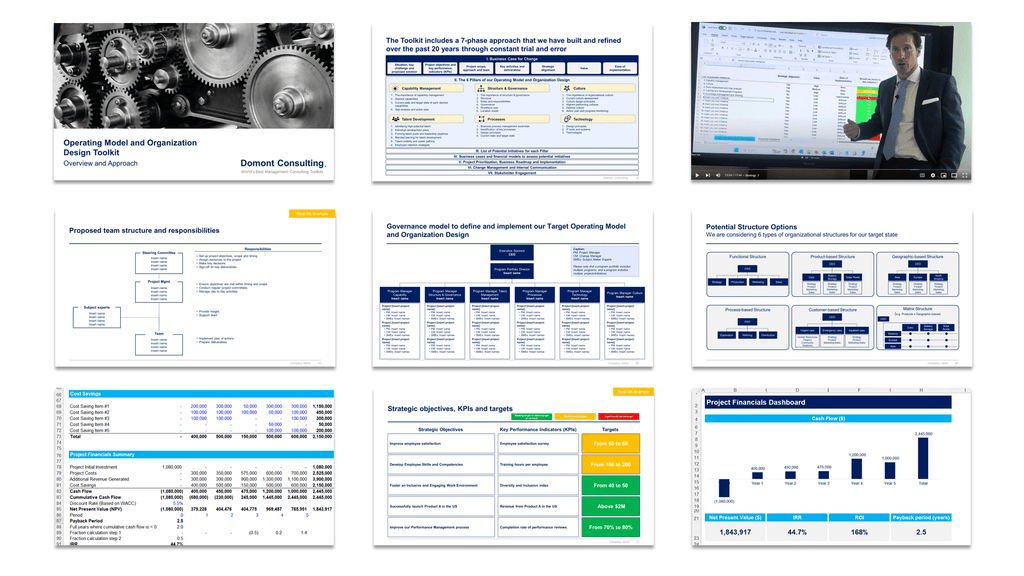Operating Model and Organization Design Approach - Templates and Free sample

Download a free sample of our approach in PPT using a computer:
Operating Model and Organization Design Approach
Context: Having a great operating model and organization design is more important than ever.
Problem: Fewer than half of the reorganization efforts are successful.
Solution: Our ex-McKinsey, Deloitte & BCG consultants created a Toolkit to help you reach your value creation objectives.
Approach: Our Toolkit includes a 7-phase approach that we have built and refined over the past 20 years through constant trial and error: (I) Business Case for Change, (II) The 6 Pillars of our Operating Model and Organization Design, (III) List of Potential Initiatives for each Pillar, (IV) Business cases and financial models to assess potential initiatives, (V) Project Prioritization, Business Roadmap and Implementation, (VI) Change Management and Internal Communication, (VII) Stakeholder Engagement.
Phase 1: Carry out your business case for change
This phase includes 7 sections: (1) Situation, key challenge and proposed solution, (2) Project objectives and key performance indicators (KPIs), (3) Project scope, approach and team, (4) Key activities and deliverables, (5) Strategic alignment, (6) Value: project initial investment, project costs, additional revenue generated, cost savings, cash flows and net present value, (7) Ease of implementation.
Phase 2: Define your operating model and organization design
This phase includes 6 sections: (1) Capability management, (2) Structure and governance, (3) Culture, (4) Talent management, (5) Processes, (6) Technology, (6) Culture.
Phase 3: List your potential initiatives
This phase lists for each pillar all the potential initiatives required to design and successfully implement the new operating model and organization design.
Phase 4: Create your business cases and financial models to assess potential initiatives
This phase includes the creation of a business case and financial model to assess each potential initiative based on (1) Strategic alignment, (2) Value and (3) Ease of implementation.
Phase 5: Prioritize, plan and implement your projects
This phase includes 8 sections: (1) Project prioritization, (2) Business roadmap, (3) Governance, (4) Dashboards, (5) Project implementation: agile methodology, design thinking and traditional methodology, (6) Continuous improvement (7) Post projects evaluation and lessons learnt, (8) Post program evaluation and lessons learnt.
Phase 6: Define and implement your change management strategy and internal communication strategy
This phase includes 4 sections: (1) Change management strategy, (2) Change management plans, (3) Implementation, tracking and progress management, (4) Effective communication.
Phase 7: Engage your stakeholders effectively
This phase includes 3 sections: (1) Stakeholder analysis, (2) Stakeholder engagement strategy, (3) Stakeholder engagement detailed plan
Download a free sample of our approach in PowerPoint using a computer:
Need more help? Check our Toolkits:
- Operating Model and Organization Design Toolkit
- Post Merger Integration Toolkit
- Management Consulting Toolkit
- Corporate and Business Strategy Toolkit
- Sales, Marketing & Communication Strategy Toolkit


